
A more recent article on substance misuse in adults is available.
Am Fam Physician. 2013;88(2):113-121
Author disclosure: No relevant financial affiliations.
Substance misuse is common among patients in primary care settings. Although it has a substantial health impact, physicians report low levels of preparedness to identify and assist patients with substance use disorders. An effective approach to office-based treatment includes a coherent framework for identifying and managing substance use disorders and specific strategies to promote behavior change. Brief validated screening tools allow rapid and efficient identification of problematic drug use, including prescription medication misuse. After a positive screening, a brief assessment should be performed to stratify patients into three categories: hazardous use, substance abuse, or substance dependence. Patients with hazardous use benefit from brief counseling by a physician. For patients with substance abuse, brief counseling is also indicated, with the addition of more intensive ongoing follow-up and reevaluation. In patients with substance dependence, best practices include a combination of counseling, referral to specialty treatment, and pharmacotherapy (e.g., drug tapering, naltrexone, buprenorphine, methadone). Comorbid mental illness and intimate partner violence are common in patients with substance use disorders. The use of a motivational rather than a confrontational communication style during screening, counseling, and treatment is important to improve patient outcomes.
Illicit substance use is common in the general population and among persons presenting for primary care. Forty-seven percent of 12th graders report that they have used an illicit drug in the past year,1 and 22.5 million persons older than 12 years meet criteria for substance abuse or dependence.2 The consequences of illicit substance use include increased morbidity and mortality, loss of productivity, and increased health care costs.3
| Clinical recommendation | Evidence rating | References | Comments |
|---|---|---|---|
| Rapid screening for substance misuse or substance use disorders can be performed in the primary care setting with a validated single-question screening tool. | C | 11 | The U.S. Preventive Services Task Force concludes that there is insufficient evidence to recommend screening for the use of substances other than alcohol and tobacco |
| Patients with hazardous substance use or substance use disorders may benefit from brief counseling by their primary care physician. | B | 16–18 | Systematic review for alcohol; randomized controlled trial and before-after study for other substance use |
| Office-based pharmacotherapy for opioid dependence using buprenorphine is safe and effective. | A | 26, 27 | Cochrane review and multiple randomized controlled trials |
| Patients with substance use disorders may benefit from identification and treatment of comorbid psychiatric disorders. | A | 44–47 | Systematic reviews and randomized controlled trials |
| Patients with substance use disorders should be routinely screened for intimate partner violence. | C | 50, 51 | Expert consensus, but no randomized controlled trials |
The most significant recent trend in illicit substance use has been a dramatic increase in the misuse of prescription medications, particularly opioids. Emergency department visits involving misuse or abuse of prescription medications increased 98.4% between 2004 and 2009,4 with corresponding dramatic increases in new users, entry into drug treatment, and overdose deaths related to prescription medications.2,5,6
Physicians may feel inadequately prepared to meet the needs of these patients. In the largest study on how primary care physicians address substance use disorders, less than 20% described themselves as very prepared to identify alcoholism or illegal drug use, and more than 50% of patients with substance use disorders said their primary care physician did nothing to address their substance abuse.7
There is increasing recognition of the similarities between substance use disorders and other common chronic illnesses such as hypertension and diabetes mellitus.8 Like those illnesses, substance use disorders can be identified early when there have been fewer sequelae and when less intensive treatments can be successful. The purpose of this article is to provide the primary care physician with a practical framework for the management of substance use disorders other than alcohol and nicotine dependence (Figure 1).
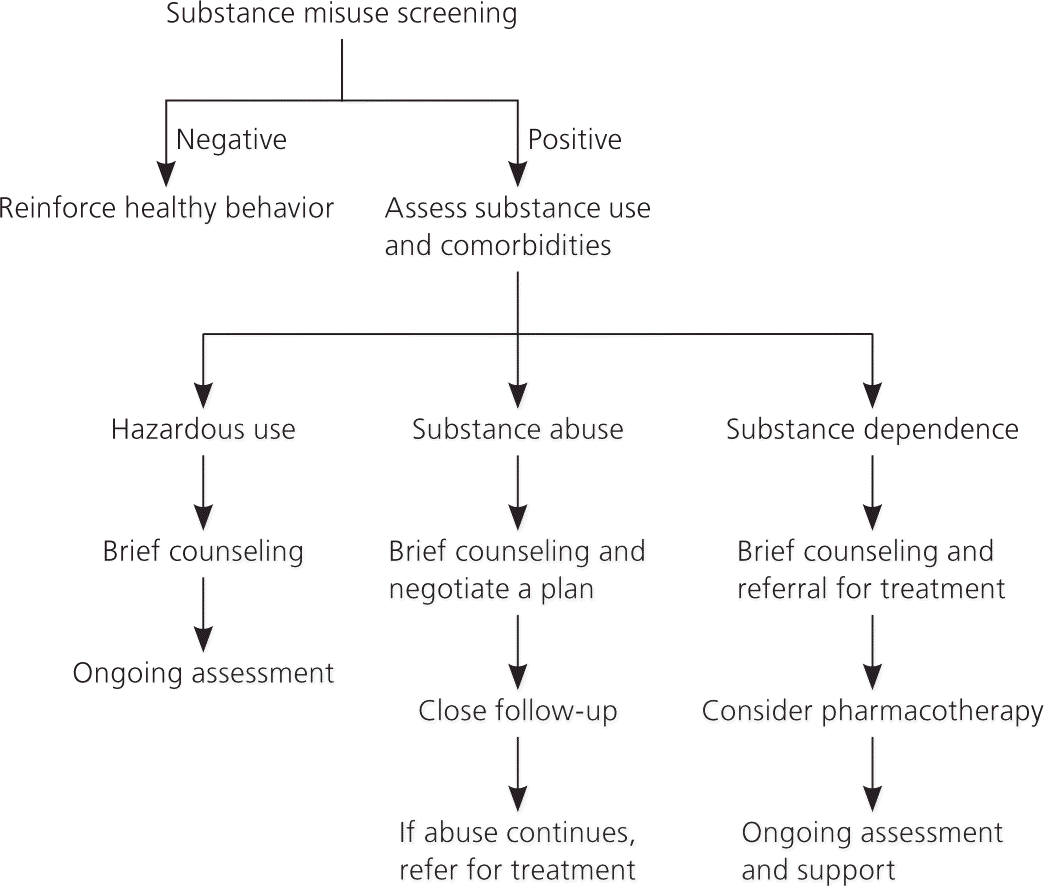
Screening
The U.S. Preventive Services Task Force recommends screening all patients for alcohol misuse,9 but has determined that there is currently insufficient evidence to recommend screening for other substance use disorders.10 Despite the lack of evidence that screening for substance use disorders improves outcomes, universal screening may be justified based on the high prevalence and morbidity of substance use and proven effectiveness of treatment. Two brief validated screening tools are presented in Table 1.11–13 The Drug Abuse Screening Test-10 is a self-report instrument that accurately identifies substance abuse and dependence.12–14 Experienced physicians may prefer to use a less structured interview to assess the role and impact of substance use and to elicit diagnostic criteria (Table 2).15 Routine urine drug testing is not recommended, but can be used to support a suspected diagnosis, assess for polysubstance use, and monitor treatment response.
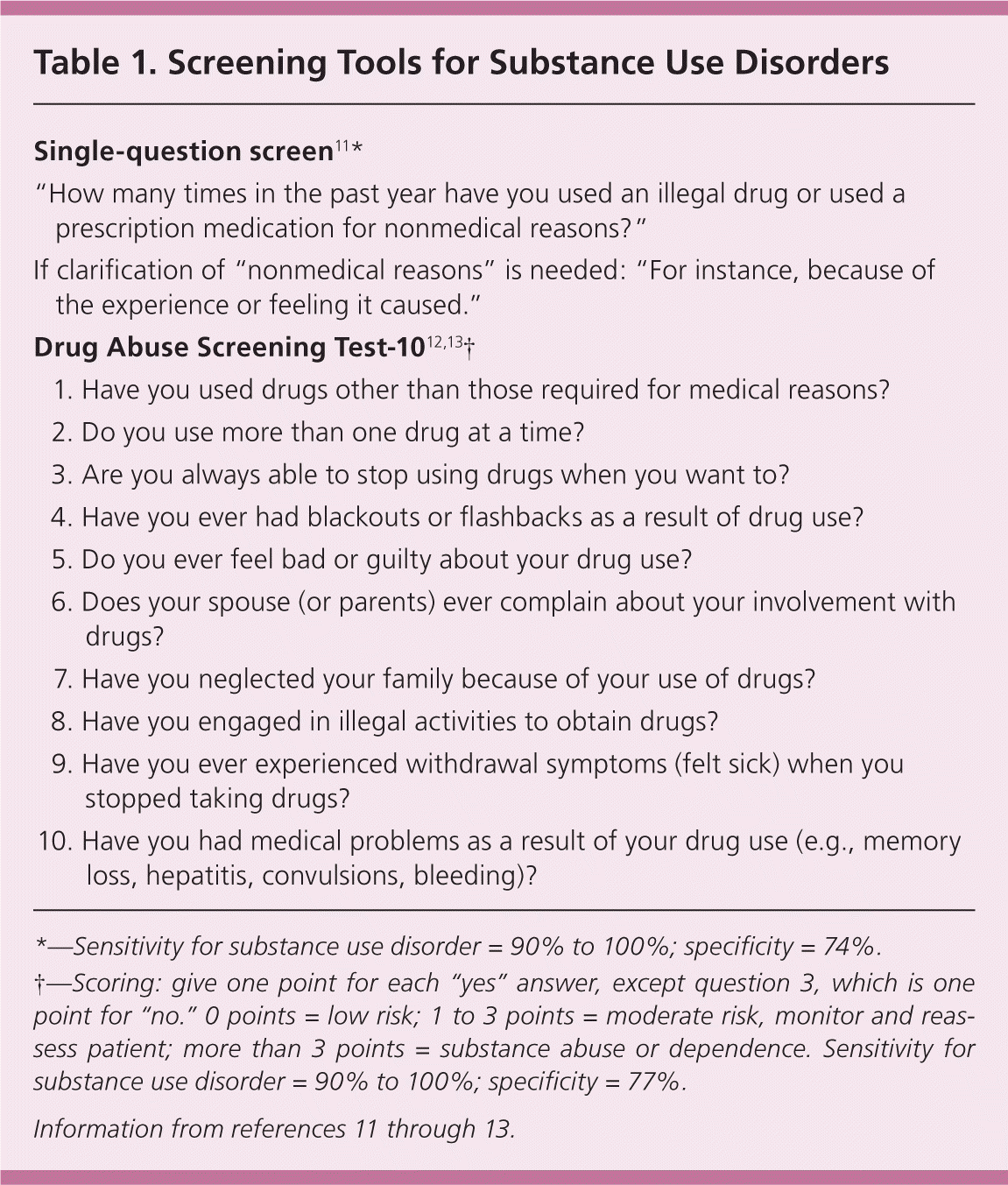
| Single-question screen11 * | |
| “How many times in the past year have you used an illegal drug or used a prescription medication for nonmedical reasons?” | |
| If clarification of “nonmedical reasons” is needed: “For instance, because of the experience or feeling it caused.” | |
| Drug Abuse Screening Test-1012,13 † | |
| 1. Have you used drugs other than those required for medical reasons? | |
| 2. Do you use more than one drug at a time? | |
| 3. Are you always able to stop using drugs when you want to? | |
| 4. Have you ever had blackouts or flashbacks as a result of drug use? | |
| 5. Do you ever feel bad or guilty about your drug use? | |
| 6. Does your spouse (or parents) ever complain about your involvement with drugs? | |
| 7. Have you neglected your family because of your use of drugs? | |
| 8. Have you engaged in illegal activities to obtain drugs? | |
| 9. Have you ever experienced withdrawal symptoms (felt sick) when you stopped taking drugs? | |
| 10. Have you had medical problems as a result of your drug use (e.g., memory loss, hepatitis, convulsions, bleeding)? | |
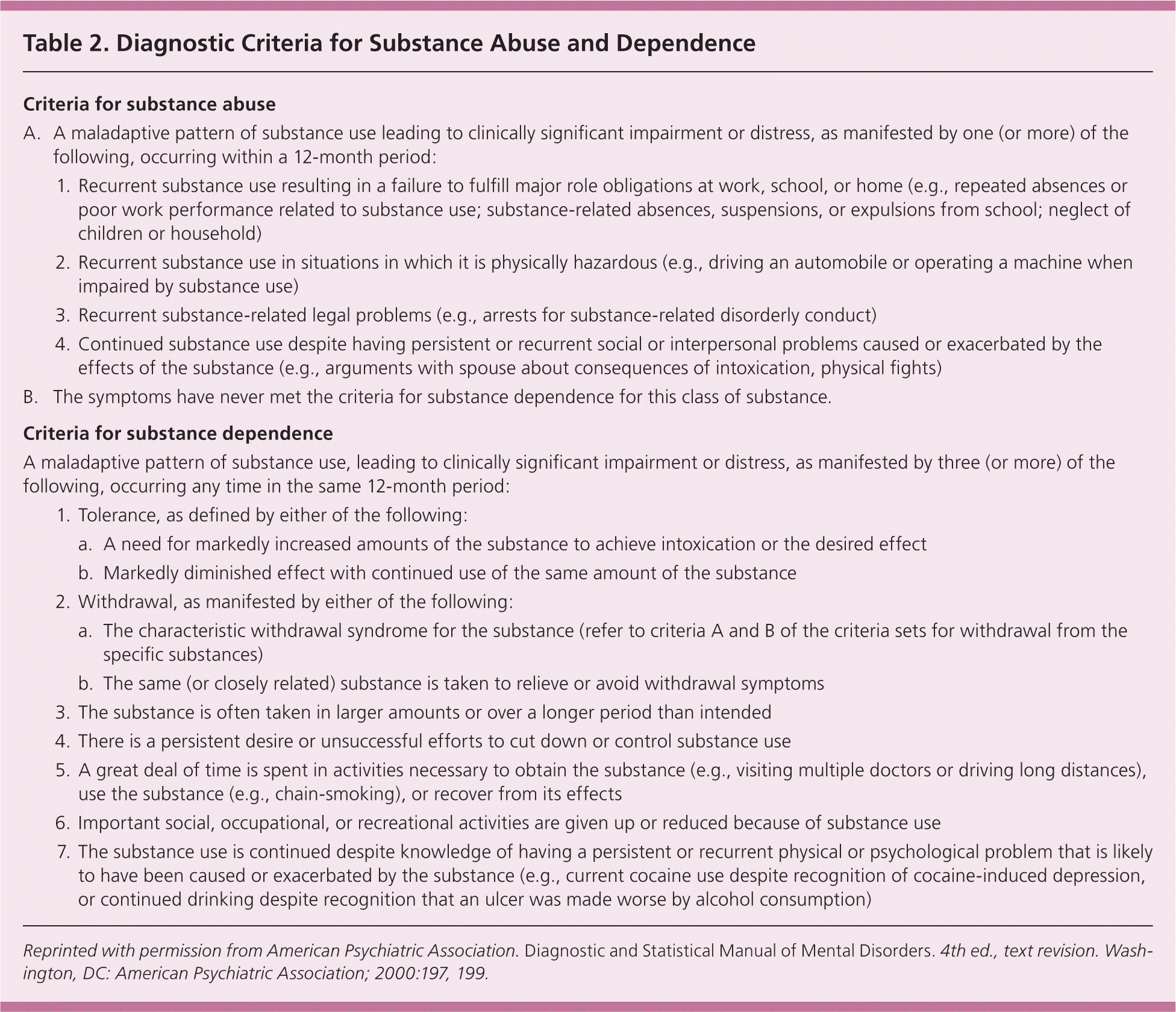
| Criteria for substance abuse | |||
| A. | A maladaptive pattern of substance use leading to clinically significant impairment or distress, as manifested by one (or more) of the following, occurring within a 12-month period: | ||
| 1. Recurrent substance use resulting in a failure to fulfill major role obligations at work, school, or home (e.g., repeated absences or poor work performance related to substance use; substance-related absences, suspensions, or expulsions from school; neglect of children or household) | |||
| 2. Recurrent substance use in situations in which it is physically hazardous (e.g., driving an automobile or operating a machine when impaired by substance use) | |||
| 3. Recurrent substance-related legal problems (e.g., arrests for substance-related disorderly conduct) | |||
| 4. Continued substance use despite having persistent or recurrent social or interpersonal problems caused or exacerbated by the effects of the substance (e.g., arguments with spouse about consequences of intoxication, physical fights) | |||
| B. | The symptoms have never met the criteria for substance dependence for this class of substance. | ||
| Criteria for substance dependence | |||
| A maladaptive pattern of substance use, leading to clinically significant impairment or distress, as manifested by three (or more) of the following, occurring any time in the same 12-month period: | |||
| 1. Tolerance, as defined by either of the following: | |||
| a. A need for markedly increased amounts of the substance to achieve intoxication or the desired effect | |||
| b. Markedly diminished effect with continued use of the same amount of the substance | |||
| 2. Withdrawal, as manifested by either of the following: | |||
| a. The characteristic withdrawal syndrome for the substance (refer to criteria A and B of the criteria sets for withdrawal from the specific substances) | |||
| b. The same (or closely related) substance is taken to relieve or avoid withdrawal symptoms | |||
| 3. The substance is often taken in larger amounts or over a longer period than intended | |||
| 4. There is a persistent desire or unsuccessful efforts to cut down or control substance use | |||
| 5. A great deal of time is spent in activities necessary to obtain the substance (e.g., visiting multiple doctors or driving long distances), use the substance (e.g., chain-smoking), or recover from its effects | |||
| 6. Important social, occupational, or recreational activities are given up or reduced because of substance use | |||
| 7. The substance use is continued despite knowledge of having a persistent or recurrent physical or psychological problem that is likely to have been caused or exacerbated by the substance (e.g., current cocaine use despite recognition of cocaine-induced depression, or continued drinking despite recognition that an ulcer was made worse by alcohol consumption) | |||
Assessment
In patients with positive screening results, substance use should be stratified into hazardous use, substance abuse, or substance dependence. For most substances, even infrequent use is considered hazardous because of potential health consequences, the risk of dependence, and the risk of legal repercussions. However, not all substance use is equally hazardous. Evidence suggests that the use of heroin, methamphetamine, and crack cocaine is associated with an intrinsically high risk of harm to self and others.3 In contrast, the use of ecstasy and marijuana seems to have intrinsically lower (but not negligible) risk of harm, but can still represent a risky choice in the context of young age, genetic predisposition to dependence, unstable social circumstances, heavy use, or impaired coping mechanisms. Physician judgment is important in determining the appropriate intervention or advice regarding hazardous substance use.
Counseling
Brief counseling is indicated for patients with hazardous substance use or substance abuse. Patients with substance dependence require more intensive treatment.
HAZARDOUS USE
Patients with hazardous substance use may benefit from brief counseling by a physician. Counseling using a motivational interviewing approach in the clinical setting has been shown to decrease the quantity and frequency of drug and alcohol use.16–18 During counseling, the physician elicits the patient's own reasons for change, rather than telling the patient why he or she should change. Confronting or pushing the patient to change is usually not successful and can decrease motivation for change.19 Helpful communication strategies for discussing behavior change are illustrated in Table 3, including the “elicit-provide-elicit” technique, which is a useful approach for providing information or advice.19
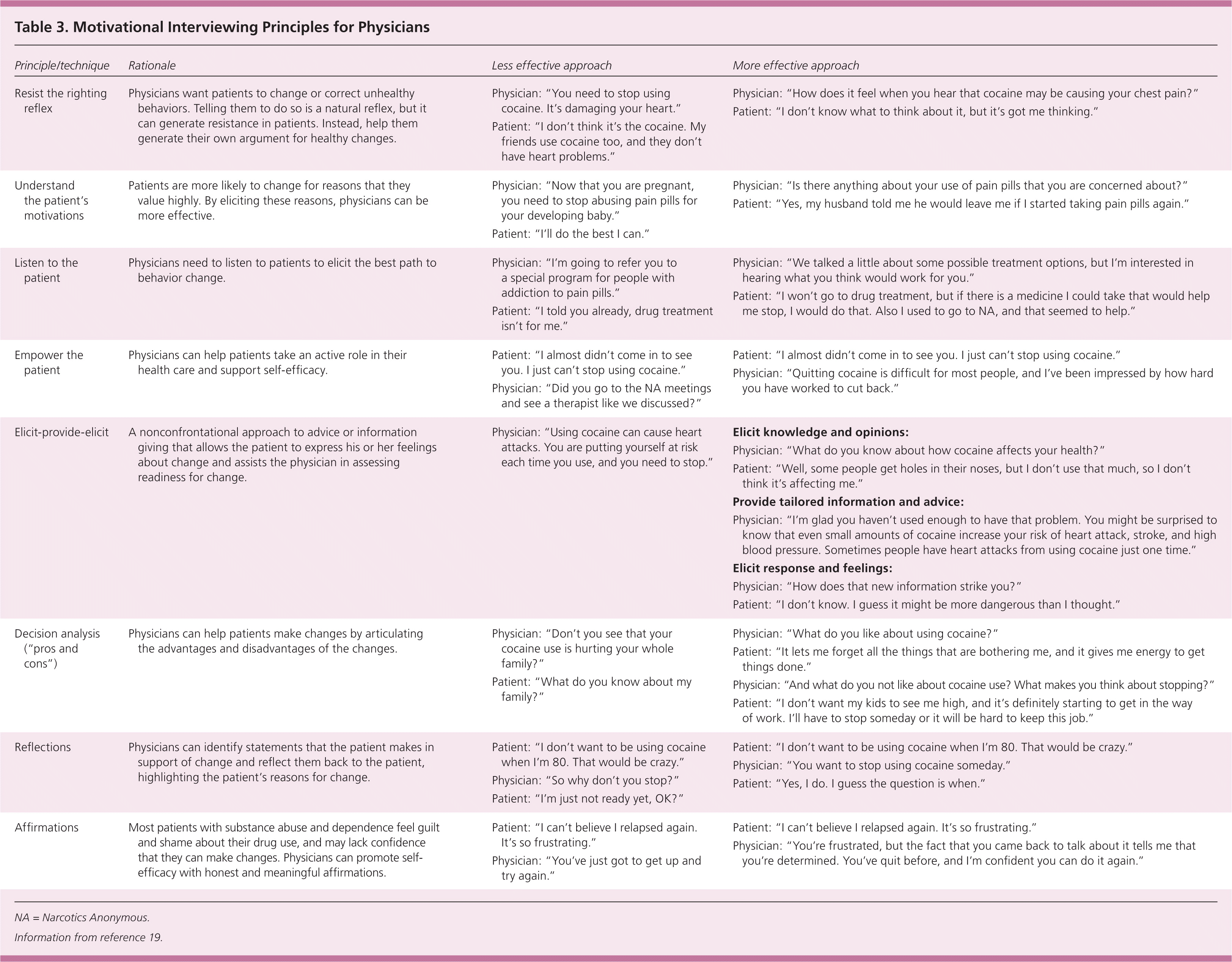
| Principle/technique | Rationale | Less effective approach | More effective approach |
|---|---|---|---|
| Resist the righting reflex | Physicians want patients to change or correct unhealthy behaviors. Telling them to do so is a natural reflex, but it can generate resistance in patients. Instead, help them generate their own argument for healthy changes. |
|
|
| Understand the patient's motivations | Patients are more likely to change for reasons that they value highly. By eliciting these reasons, physicians can be more effective. |
|
|
| Listen to the patient | Physicians need to listen to patients to elicit the best path to behavior change. |
|
|
| Empower the patient | Physicians can help patients take an active role in their health care and support self-efficacy. |
|
|
| Elicit-provide-elicit | A nonconfrontational approach to advice or information giving that allows the patient to express his or her feelings about change and assists the physician in assessing readiness for change. |
| Elicit knowledge and opinions:
|
Provide tailored information and advice:
| |||
Elicit response and feelings:
| |||
| Decision analysis (“pros and cons”) | Physicians can help patients make changes by articulating the advantages and disadvantages of the changes. |
|
|
| Reflections | Physicians can identify statements that the patient makes in support of change and reflect them back to the patient, highlighting the patient's reasons for change. |
|
|
| Affirmations | Most patients with substance abuse and dependence feel guilt and shame about their drug use, and may lack confidence that they can make changes. Physicians can promote self-efficacy with honest and meaningful affirmations. |
|
|
SUBSTANCE ABUSE
Substance abuse is characterized by the development of consequences from substance use, and these consequences can serve as motivators for change. The primary care physician can be instrumental in increasing motivation, but should be prepared for patients' feelings of defensiveness, ambivalence, guilt, shame, and lack of concern about their substance use. Principles and techniques derived from motivational interviewing can be used to manage resistance and increase readiness to change.
For patients with substance abuse, experts generally recommend advising abstinence. For patients who are not committed to abstinence, it is useful to provide a variety of options for change, and harm reduction is an appropriate goal. Harm reduction strategies reduce the negative health consequences of substance use. Common examples include providing clean needles to persons who continue to inject drugs, and not driving while intoxicated. Developing a plan for change is an opportunity for physician-patient collaboration and trust building. If a patient with substance abuse agrees to cut back or quit but is unable to do so, this may indicate a substance dependence disorder.
SUBSTANCE DEPENDENCE
Substance dependence is a chronic relapsing and remitting illness, and patients require a longitudinal, chronic care approach that can include pharmacotherapy, referral to specialty treatment, mutual help meetings, and ongoing counseling and care coordination.
Brief counseling can help an ambivalent patient with substance dependence to enter a treatment program, engage with mutual help meetings, or agree to a trial of pharmacotherapy. Because of the severity of substance dependence disorders and the importance of family support in the recovery process,20 physicians should engage family members in the treatment plan when appropriate and with the patient's consent. Treatment programs that involve families have improved rates of retention and abstinence.21–23
Pharmacotherapy
Pharmacologic treatments are available for managing acute withdrawal, reducing or eliminating use, and preventing relapse for a variety of substances, including tobacco, alcohol, benzodiazepines, and opioids. Physicians should not restrict the use of pharmacotherapy only to patients whose goal is abstinence. Reductions in the amount or frequency of drug and alcohol use have important health correlates. For example, even small reductions in alcohol consumption translate into substantial decreases in the risks of cancer, hypertension, and other conditions.24
Three drugs are approved by the U.S. Food and Drug Administration (FDA) for the treatment of opioid dependence. Buprenorphine and naltrexone (Revia) can be prescribed from office-based practices and clinics. Treatment with methadone is restricted to federally regulated narcotic treatment programs.
OPIOID AGONISTS: BUPRENORPHINE AND METHADONE
Buprenorphine is a partial agonist of mu opioid receptors. Formulations approved by the FDA for the treatment of opioid dependence include sublingual buprenorphine and sublingual buprenorphine/naloxone tablets or strips (Suboxone). The naloxone component is poorly absorbed via the sublingual route and is present only to prevent misuse of the medication by crushing and injecting the combined product. Because of this safety feature, buprenorphine/naloxone is the preferred formulation.
Brief treatment periods with rapid medication tapers (medical withdrawal) are associated with high rates of relapse25; therefore, longer-term or maintenance treatment is generally indicated for patients with opioid dependence. Treatment with buprenorphine is safe and effective,26,27 and many patients can manage the induction period on their own at home.28
Physicians who wish to prescribe buprenorphine for treatment of opioid dependence are required to complete eight hours of training and to obtain a waiver from the Center for Substance Abuse Treatment and Drug Enforcement Administration. Complete information is available at http://buprenorphine.samhsa.gov, and support is available from the Physicians' Clinical Support System–Buprenorphine at http://www.pcssb.org. Buprenorphine treatment of opioid dependence has been described previously in American Family Physician (https://www.aafp.org/afp/2006/0501/p1573.html).29
Some patients are not candidates for office-based treatment of opioid dependence, and should be referred to a narcotic treatment program where they can receive methadone pharmacotherapy and counseling services. Methadone maintenance therapy reduces opioid abuse and associated harms.30–32 Common indications for referral include comorbid chronic pain that requires opioid therapy, co-occurring alcohol or benzodiazepine abuse, an uncontrolled or unstable psychiatric disorder, or if treatment in the office setting has been ineffective.33
OPIOID ANTAGONIST: NALTREXONE
Naltrexone is an antagonist of mu opioid receptors and can block the effects of opioid agonists.34 This can prevent the impulsive use of opioids in patients receiving naltrexone, and can provide time for the patient to consider the consequences of relapse and to seek support. Naltrexone is available as a 50-mg tablet taken daily or, alternatively, 100 mg on Mondays and Wednesdays, and 150 mg on Fridays. A 380-mg monthly injection (Vivitrol) is in widespread use for treatment of alcohol dependence, and was recently approved by the FDA for treatment of opioid dependence.
Naltrexone has been shown to be helpful in maintaining abstinence from opioids in motivated populations, such as health care professionals who cannot or do not wish to take continuous opioid agonist therapy.35 However, it has had limited success in other groups.36 Naltrexone has been associated with hepatic injury at supratherapeutic doses; therefore, liver function tests at baseline and every three to six months are recommended.37 Naltrexone cannot be used in patients in whom opioids are required for pain control, because it will block pain relief from opioid agonists and cause precipitated withdrawal in patients who are currently taking opioids. Patients who discontinue treatment are at increased risk of opioid overdose and death resulting from decreased opioid tolerance.38
BENZODIAZEPINE DEPENDENCE
Physicians may attempt a slow taper (usually over months) of benzodiazepines in selected patients with dependence and in whom a reliable history can be obtained about the amount being taken. Patients should be motivated and adherent, and should not have a history of withdrawal seizures or other medical comorbidities.39 Other patients should generally be referred to a specialist, if possible. Risks of tapering benzodiazepines include increased anxiety and depression symptoms, seizures, and altered mental status.40
STIMULANT DEPENDENCE
Despite continued research efforts and several potential candidate medications, no pharmacologic treatment for stimulant (e.g., cocaine, methamphetamine) dependence can be recommended for use in the primary care setting.41 Behavioral therapies have demonstrated effectiveness in the treatment of stimulant dependence.42
Referral
Referral for specialty addiction treatment is recommended for patients with substance dependence disorders. However, primary care physicians with appropriate experience, training, and support can provide some or all of these services. Access to substance abuse treatment is variable, and decisions about where to refer patients must take into account local resources and patient characteristics. Table 4 provides a list of resources for the most commonly available treatment options.39 Physicians can develop consultation relationships with treatment centers and specialists in their communities to help them determine the appropriate level of care for patients and to facilitate referrals. Patients in specialty addiction treatment benefit from close primary care coordination, particularly regarding prescriptions for controlled substances or other psychoactive medications. Referral for psychiatric or pain management consultation may also be appropriate based on the presentation and response to treatment.
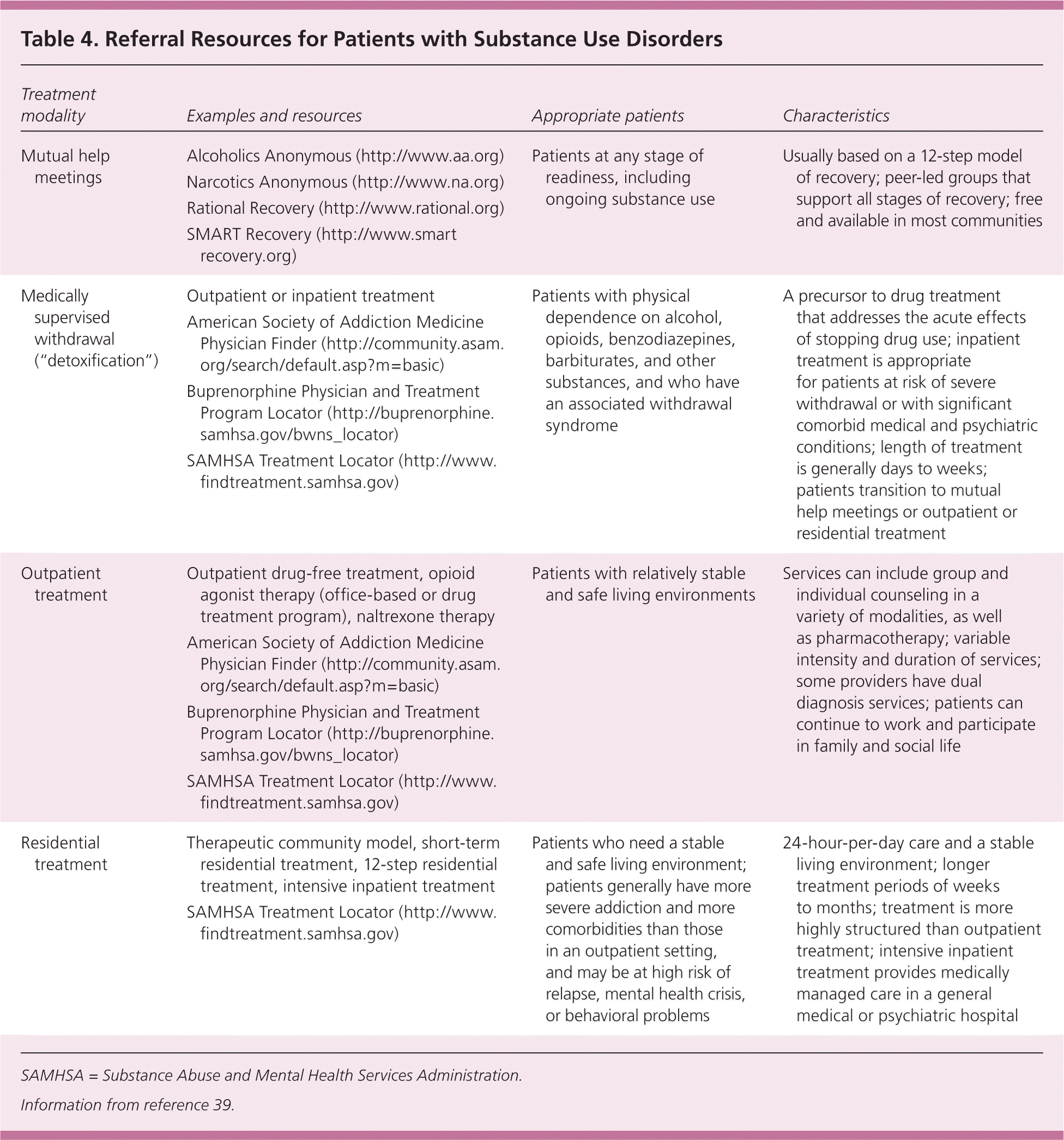
| Treatment modality | Examples and resources | Appropriate patients | Characteristics |
|---|---|---|---|
| Mutual help meetings | Alcoholics Anonymous (http://www.aa.org) | Patients at any stage of readiness, including ongoing substance use | Usually based on a 12-step model of recovery; peer-led groups that support all stages of recovery; free and available in most communities |
| Narcotics Anonymous (http://www.na.org) | |||
| Rational Recovery (http://www.rational.org) | |||
| SMART Recovery (http://www.smartrecovery.org) | |||
| Medically supervised withdrawal (“detoxification”) | Outpatient or inpatient treatment | Patients with physical dependence on alcohol, opioids, benzodiazepines, barbiturates, and other substances, and who have an associated withdrawal syndrome | A precursor to drug treatment that addresses the acute effects of stopping drug use; inpatient treatment is appropriate for patients at risk of severe withdrawal or with significant comorbid medical and psychiatric conditions; length of treatment is generally days to weeks; patients transition to mutual help meetings or outpatient or residential treatment |
| American Society of Addiction Medicine Physician Finder (http://community.asam.org/search/default.asp?m=basic) | |||
| Buprenorphine Physician and Treatment Program Locator (http://buprenorphine.samhsa.gov/bwns_locator) | |||
| SAMHSA Treatment Locator (http://www.findtreatment.samhsa.gov) | |||
| Outpatient treatment | Outpatient drug-free treatment, opioid agonist therapy (office-based or drug treatment program), naltrexone therapy | Patients with relatively stable and safe living environments | Services can include group and individual counseling in a variety of modalities, as well as pharmacotherapy; variable intensity and duration of services; some providers have dual diagnosis services; patients can continue to work and participate in family and social life |
| American Society of Addiction Medicine Physician Finder (http://community.asam.org/search/default.asp?m=basic) | |||
| Buprenorphine Physician and Treatment Program Locator (http://buprenorphine.samhsa.gov/bwns_locator) | |||
| SAMHSA Treatment Locator (http://www.findtreatment.samhsa.gov) | |||
| Residential treatment | Therapeutic community model, short-term residential treatment, 12-step residential treatment, intensive inpatient treatment | Patients who need a stable and safe living environment; patients generally have more severe addiction and more comorbidities than those in an outpatient setting, and may be at high risk of relapse, mental health crisis, or behavioral problems | 24-hour-per-day care and a stable living environment; longer treatment periods of weeks to months; treatment is more highly structured than outpatient treatment; intensive inpatient treatment provides medically managed care in a general medical or psychiatric hospital |
| SAMHSA Treatment Locator (http://www.findtreatment.samhsa.gov) |
Comorbidities
MENTAL HEALTH
Anxiety disorders, depression, bipolar disorder, posttraumatic stress disorder, and dependent and antisocial personality disorders are more common in patients with substance use disorders (particularly substance dependence disorders).43–46 The presence of a substance use disorder suggests the need for mental health screening.
Mental health disorders can be primary or secondary (substance induced). Primary disorders generally predate the onset of substance misuse, and symptoms are present during periods of abstinence.41 Primary comorbid mental health disorders can be treated with standard psychological and pharmacologic therapies.47–49
INTIMATE PARTNER VIOLENCE
Men and women who misuse illicit drugs are at increased risk of being victims and perpetrators of intimate partner violence.50,51 Because rates of intimate partner violence exceed 50% in patients with drug use disorders in some settings,50 it is recommended that physicians screen all patients who present with substance use disorders for intimate partner violence.
Although management of intimate partner violence is beyond the scope of this article, perpetration and victimization appear to be decreased by treatment of alcohol use disorders,50 suggesting that substance abuse treatment may be an effective intervention.
Follow-up
Although there are no established guidelines, it is reasonable to follow up with patients within four to six weeks after identifying risky drug use or a substance use disorder. Because the severity and intensity of drug use may evolve, regular reassessment is indicated. In early recovery, patients are at an increased risk of relapse, and physicians can offer support and reinforce healthy behaviors. Relapse can be a source of shame and guilt for patients. Physicians can help by ensuring that their office is a safe and blame-free place for patients with drug problems, and by adopting a nonjudgmental and welcoming attitude toward patients in the event of relapse.
Data Sources: A PubMed search was completed in Clinical Queries using the key terms SBIRT, substance abuse, screening, buprenorphine, brief intervention, motivational interviewing, treatment, dual diagnosis, intimate partner violence, methadone, hazardous use, risky use, drug abuse, screening tool, and naltrexone. The search included meta-analyses, randomized controlled trials, clinical trials, and reviews. Also searched were the Cochrane database, Essential Evidence Plus, the National Guideline Clearinghouse database, the Drug Abuse Warning Network database, and the Substance Abuse and Mental Health Services Administration's National Survey on Drug Use and Health. Search dates: January 16, 2011; March 23, 2011; and June 20, 2011.
